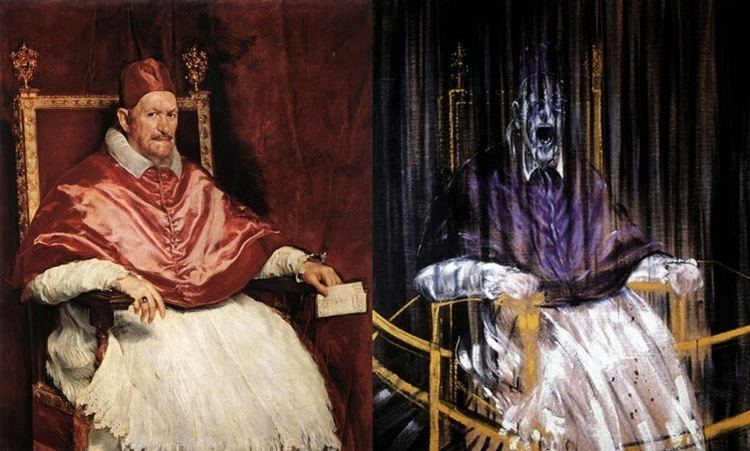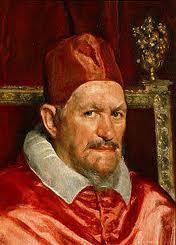Papacy began 15 September 1644 | Name Pope X Papacy ended 7 January 1655 | |
 | ||
Created Cardinal 19 November 1629by Urban VIII Birth name Giovanni Battista Pamphilj or Pamphili Previous post Legate to France (1625)Titular Latin Patriarch of Antioch (1626-1629)Apostolic Nuncio to Spain (1626-1629)Cardinal-Priest of Sant'Eusebio (1629-1644)Prefect of the Sacred Congregation for the Clergy (1639-1644)Camerlengo of the Holy Roman Church (1643-1644) Education Pontifical Gregorian University Parents Maria del Bufalo Cancellieri Flaminia, Camillo Pamphili Similar People | ||
Art bros study after vel zquez s portrait of pope innocent x francis bacon
Pope Innocent X (Latin: Innocentius X; 6 May 1574 – 7 January 1655), born Giovanni Battista Pamphilj (or Pamphili), was Pope from 15 September 1644 to his death in 1655.
Contents
- Art bros study after vel zquez s portrait of pope innocent x francis bacon
- Pope Innocent X Wikipedia audio article
- Early life
- Election
- Relations with France
- Relations with Parma
- English Civil War
- Olimpia Maidalchini
- Death and legacy
- Literature
- References

Born in Rome of a family from Gubbio in Umbria who had come to Rome during the pontificate of Pope Innocent IX, he graduated from the Collegio Romano and followed a conventional cursus honorum, following his uncle Girolamo Pamphilj as auditor of the Rota, and like him, attaining the dignity of Cardinal-Priest of Sant'Eusebio, in 1629.

Trained as a lawyer, he succeeded Pope Urban VIII (1623–44) on 15 September 1644, as one of the most politically shrewd pontiffs of the era, who greatly increased the temporal power of the Holy See.

Pope Innocent X | Wikipedia audio article
Early life

Giovanni Battista Pamphili was born in Rome on 5 May 1574, the son of Camillo Pamphili, of the Roman Pamphili family. The family, originally from Gubbio, was directly descended from Pope Alexander VI.

In 1594 he graduated from the Collegio Romano and followed a conventional cursus honorum. He served as a Consistorial lawyer in 1601, and in 1604 succeeded his uncle, Cardinal Girolamo Pamphilj, as auditor of the Roman Rota, the ecclesiastical appellate tribunal. He was also a canonist of the Sacred Apostolic Penitentiary, a second tribunal.

In 1623 Pope Gregory XV sent him as nuncio to the court of the Kingdom of Naples. In 1625 Urban VIII sent him to accompany his nephew, Francesco Barberini, whom he had accredited as nuncio, first to France and then Spain. In January 1626 Pamphili was appointed titular Latin Patriarch of Antioch.
In reward for his labors, in May 1626 Giovanni Battista was made apostolic nuncio to the court of Philip IV of Spain. The position led to a lifelong association with the Spaniards which was of great use during the papal conclave of 1644.
Election
The 1644 conclave for the election of a successor to Urban VIII was long and stormy, lasting from 9 August to 15 September. The large French faction led by Pope Urban's nephews objected to the Spanish candidate, as an enemy of Cardinal Mazarin, who guided French policy. They put up their own candidate (Giulio Cesare Sacchetti) but could not establish enough support for him and agreed to Pamphili as an acceptable compromise, though he had served as legate to Spain. Mazarin, bearing the French veto of Cardinal Pamphiij, arrived too late, and the election was accomplished.
Relations with France
Soon after his accession, Innocent X (as he chose to be called) initiated legal action against the Barberini for misappropriation of public funds. The brothers Francesco Barberini, Antonio Barberini and Taddeo Barberini fled to Paris, where they found a powerful protector in Cardinal Mazarin. Innocent X confiscated their property, and on 19 February 1646, issued a bull ordaining that all cardinals who might leave the Papal States for six months without express papal permission would be deprived of their benefices and eventually of their cardinalate itself. The French parliament declared the papal ordinance void in France, but Innocent X did not yield until Mazarin prepared to send troops to Italy. Henceforth the papal policy towards France became more friendly, and somewhat later the Barberini were rehabilitated when the son of Taddeo Barberini, Maffeo Barberini, married Olimpia Giustiniani, a niece of Innocent X.
In 1653, Innocent X with the Cum occasione papal bull condemned five propositions of Jansenius's Augustinus, inspired by St. Augustine, as heretical and close to Lutheranism. This led to the formulary controversy, Blaise Pascal's writing of the Lettres Provinciales, and finally to the razing of the Jansenist convent of Port-Royal and the subsequent dissolving of its community.
Relations with Parma
The death of Pope Urban VIII is said to have been hastened by chagrin at the result of the First War of Castro, a war he had undertaken against Odoardo Farnese, the duke of Parma. Hostilities between the papacy and the Duchy of Parma resumed in 1649, and forces loyal to Pope Innocent X destroyed the city of Castro on 2 September 1649.
Innocent X objected to the conclusion of the Peace of Westphalia, which his nuncio, Fabio Chigi, protested in vain, and against which in 1650 Innocent X issued the brief Zelo Domus Dei backdated to 1648 in order to preserve potential claims for confiscated land and property. The protests were ignored by the European powers.
English Civil War
During the Civil War (1642–49) in England and Ireland, Innocent X strongly supported the independent Confederate Ireland, over the objections of Mazarin and the former English Queen and at that time Queen Mother, Henrietta Maria, exiled in Paris. The pope sent as nuncio extraordinary to Ireland, Giovanni Battista Rinuccini, archbishop of Fermo, who arrived at Kilkenny with a large quantity of arms, military supplies including 20,000 pounds of gunpowder, and a very large sum of money. Rinuccini hoped he could influence the Confederate's strategic policy away from doing a deal with Charles I and the Royalists in the English Civil War and towards the foundation of an independent Catholic-ruled Ireland.
At Kilkenny, Rinuccini was received with great honours, asserting in his Latin declaration that the object of his mission was to sustain the king but, above all, to rescue from pains and penalties the Catholic people of Ireland in securing the free and public exercise of the Catholic religion, and the restoration of the churches and church property, but, in the end, Oliver Cromwell restored Ireland to the Parliamentarian side and Rinuccini returned to Rome in 1649, after four fruitless years.
Olimpia Maidalchini
Olimpia Maidalchini, who had been married to his late brother, was believed to be Innocent X's mistress because of her influence over him in matters of promotion and politics. This state of affairs was alluded to in the Encyclopædia Britannica 9th edition (1880):
"Throughout his reign the influence exercised over him by Maidalchini, his deceased brother's wife, was very great, and such as to give rise to gross scandal, for which, however, there appears to have been no adequate ground.... The avarice of his female counsellor gave to his reign a tone of oppression and sordid greed which probably it would not otherwise have shown, for personally he was not without noble and reforming impulses."
The relationship between Olimpia and Innocent X, both before and during his papacy, is the main concern of the book Mistress of the Vatican by Eleanor Herman, published in 2008.
Death and legacy
A measure of the rivalry between two arriviste papal families, the Barberini and the Pamphili, can be judged from Guido Reni's painting of the Archangel Michael, trampling Satan in which the features of Innocent X are immediately recognized. The less-than-subtle political statement still hangs in a side chapel of the Capuchin friars' Church of the Conception (Santa Maria della Concezione) in Rome. During the papacy of Pope Urban VIII, Giovanni Battista Pamphilj was the pope's most significant rival among the College of Cardinals. Antonio Barberini, the pope's brother, was a cardinal who had begun his career with the Capuchin brothers. About 1635, at the height of the Thirty Years' War in Germany, in which the Papacy was intricately involved, Cardinal Antonio commissioned the painting of the combative archangel Michael, trampling Satan (the source of heresy and error) for the church of his old Order. He raised Colegio de Nuestra Senora del Santisimo Rosario (now University of Santo Tomas) to a University in November 20, 1645 during his pontificate.
The legend that the high-living patrician painter Guido Reni, whose personal dash was at least as great as his brilliant drawing and brushwork, had been insulted by rumours circulated, he thought, by Cardinal Pamphilj, serves to place on the painter's shoulders the vengeful act that could not have been overlooked, or discouraged, by his Barberini patron. When, a few years later, Pamphilj was raised to the papacy, other Barberini relatives fled to France on the embezzlement accusations that have been mentioned but the Capuchins held fast to their chapel altarpiece.
Innocent was responsible for raising the then Colegio de Santo Tomás de Nuestra Señora del Santísimo Rosario into the rank of a university and now the University of Santo Tomás in Manila, the oldest existing in Asia.
In 1650, Innocent X celebrated a Jubilee. He embellished Rome with inlaid floors and bas-relief in Saint Peter's, erected Bernini's Fontana dei Quattro Fiumi in Piazza Navona, the Pamphilj stronghold in Rome, and ordered the construction of Palazzo Nuovo at the Campidoglio.
Innocent X is also the subject of Portrait of Innocent X, a famous painting by Diego Velázquez housed in the family gallery of Palazzo Doria (Galleria Doria Pamphilj). This portrait inspired the "Screaming Pope" paintings by 20th century painter Francis Bacon, the most famous of which is Bacon's Study after Velázquez's Portrait of Pope Innocent X.
Innocent X died 7 January 1655, and at the conclave of 1655 was succeeded by Pope Alexander VII.
